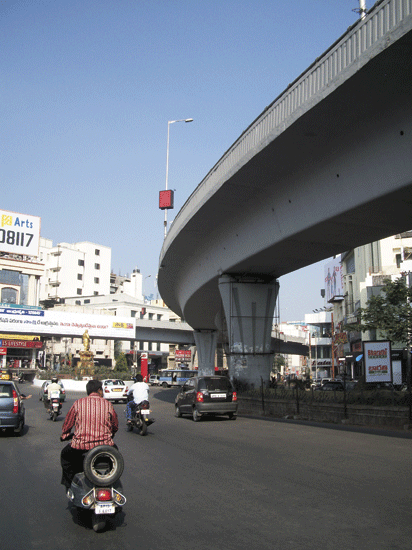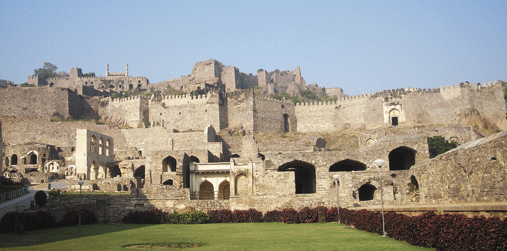

Pulsating Hyderabad
City of Four Minarets
 |
Mull over to the historical city of pearls, Hyderabad, the high-tech park of the East.
It is here where great Islamic mosques and monuments exist, best food savored and heritage experienced
through its museums, amidst a bustling metropolis of flyovers and high rises.
By Rufaida Javid
Nothing will prepare you for the scene that awaits your astonished gaze once you have made the effort to climb the steep steps in the claustrophobic atmosphere of the Charminar. There below you will see the unbelievable Old City of Hyderabad in all its chaotic glory. A sea of autorickshaws—that abiding symbol of South Asian private transport—crisscrosses the maze of narrow lanes, missing each other and carefree pedestrians, by a whisker. Sellers of bangles and pearls, textiles and spices and sweets and garments shout at the top of their lungs to attract shoppers and passersby. 
To feel the pulse of Hyderabad—a city of eight million souls—this is the place to be. The Charminar (literally “Four Minarets”) is to Hyderabad what the Big Ben is to London or the Eiffel Tower to Paris. No other monument symbolizes the city better. Sultan Mohammad Quli Qutub Shah, the grandson of Quli Qutub Shah, who founded the Qutub Shahi dynasty, built it in 1591. The Sultan prayed to God to end the plague that was ravaging his kingdom, his prayers was answered and he built the Charminar at the exact location as a result, it is said. The commanding four minarets stand at a height of 48.7 meters and when the monument was originally built, one could see the four corners of the city from each side. Charminar also houses a small mosque.
Just across the Charminar lies another wonder of Hyderabad, the Makkah Masjid. It is the biggest mosque in Hyderabad and one of the largest in India and it took 77 years to build when construction started in 1617 under Mohammad Quli Qutub Shah and completed in 1694 by the Mughal Emperor Aurangzeb.
The mosque is made of granite. French explorer Jean-Baptiste Tavernier wrote of it in his travelogue: “It is about 50 years since they began to build a splendid pagoda [Makkah Masjid] in the town which will be the grandest in all India when it is completed. The size of the stone is the subject of special accomplishment, and that of a niche, which is its place for prayer, is an entire rock of such enormous size that they spent five years in quarrying it, and 500 to 600 men were employed continually on its work.” Though the mosque is open to all visitors (except during prayer times) the most impressive view is from the top of the Charminar. 
The best way to while away time in the Old City is to lose yourself in the maze of alleyways that spring up, offering one surprise after another. Some of the best restaurants in town are located here. You can start the day early with a filling breakfast of naan (unleavened bread) and paya (soup of sheep’s hoof) at one of the restaurants. Who has not heard of the famous Hyderabadi Biryani? It can safely be concluded that its home is here in the Old City of Hyderabad. For lunch and dinner, head straight to the Shadab Hotel in the famous Madina Building. This unassuming place offers probably the best mutton biryani in town for just Rs 110 (less than SR 10).
Hyderabad, which used to be known as the City of Pearls or the City of Biryani, is today known as “Cyberabad”, as a result of the software boom that has made the city one of the hi-tech hubs of Asia. The new city is a bustling metropolis of flyovers and high-rises, of tech-parks and ring roads. However, the soul of Hyderabad is still the Old City. Urdu—or its unique Deccani dialect that is spoken here—is still the lingua franca of Hyderabad.
Another marvel of architecture in the city is the opulent Falaknuma Palace of the Nizams, the erstwhile rulers of Hyderabad. However, our effort to make it all the way to the palace was wasted, as visitors are currently not being allowed inside, as the building is under renovation and has been taken over by the Taj Group, to convert it into a five-star hotel. But the view from the outside is also stunning. 
Set aside at least three hours to sample the Golconda Fort, one of the grandest forts in India that now lies in a state of ruin. It is located to the West of the city. The Golconda Fort was constructed during the reign of the Qutub Shahi rulers and finally fell to the Mughal Emperor Aurangzeb. Make sure you do not miss the interesting light and sound show in the evening (SR 5 / 10).
Wandering around the ramparts of the fort, it is easy to imagine the grandeur of the Qutub Shahi kingdom and the extent to which they went to safeguard it. The entire fort complex is about 10kms in diameter. The kingdom collapsed after the Mughal onslaught in 1687.
If museums are your thing, then Hyderabad has something serious to offer: two of India’s best museums are found here. The Andhra Pradesh State Museum houses artifacts dating back to the first century AD. But the Salar Jung Museum is the most famous in the city. According to the Archeological Survey of India, it is “a repository of the artistic achievements of diverse European, Asian and Far Eastern countries of the world…” After the demise of Salar Jung III, in the absence of any direct heirs, the vast collection of precious art objects was taken over by the Indian Government, to be housed in the museum.
Mir Yusuf Ali Khan Salar Jung III or Salar Jung III, (1889 - 1949), was Prime Minister of the seventh Nizam of Hyderabad. It is said that he was one of the richest noblemen of his time. This museum houses the largest collection of objects by a single person anywhere in the world. Salar Jung III spent almost all his money on unbelievable rare and expensive collection of artifacts—including the famous British-manufactured Musical Clock, which is the biggest attraction at the museum, and the equally famous French-made wooden “Double Statue”. We spent four hours at this magnificent museum, admiring all along the passion and refined taste of one man. Apart from the thousands of paintings and artifacts, the museum also houses a set of ivory chairs which were gifted to Tipu Sultan, the Tiger of Mysore, by his French allies. There are a total of 77 rooms, and one of them is dedicated to the personal belongings of the man himself—Salar Jung III. It includes objects like his junior school books, pictures taken with important people of the time, his clothes etc.